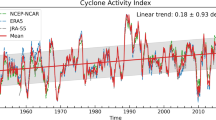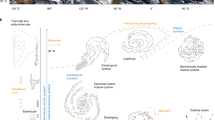Abstract
Earth’s midlatitudes are dominated by regions of large atmospheric weather variability—often referred to as storm tracks— which influence the distribution of temperature, precipitation and wind in the extratropics. Comprehensive climate models forced by increased greenhouse gas emissions suggest that under global warming the storm tracks shift poleward. While the poleward shift is a robust response across most models, there is currently no consensus on what the underlying dynamical mechanism is. Here we present a new perspective on the poleward shift, which is based on a Lagrangian view of the storm tracks. We show that in addition to a poleward shift in the genesis latitude of the storms, associated with the shift in baroclinicity, the latitudinal displacement of cyclonic storms increases under global warming. This is achieved by applying a storm-tracking algorithm to an ensemble of CMIP5 models. The increased latitudinal propagation in a warmer climate is shown to be a result of stronger upper-level winds and increased atmospheric water vapour. These changes in the propagation characteristics of the storms can have a significant impact on midlatitude climate.
This is a preview of subscription content, access via your institution
Access options
Access Nature and 54 other Nature Portfolio journals
Get Nature+, our best-value online-access subscription
$29.99 / 30 days
cancel any time
Subscribe to this journal
Receive 12 print issues and online access
$259.00 per year
only $21.58 per issue
Buy this article
- Purchase on Springer Link
- Instant access to full article PDF
Prices may be subject to local taxes which are calculated during checkout




Similar content being viewed by others
References
Blackmon, M., Wallace, J., Lau, N. & Mullen, S. An observational study of the Northern Hemisphere wintertime circulation. J. Atmos. Sci. 34, 1040–1053 (1977).
Hoskins, B. & Hodges, K. New perspectives on the Northern Hemisphere winter storm tracks. J. Atmos. Sci. 59, 1041–1061 (2002).
Ulbrich, U., Leckebusch, G. C. & Pinto, J. G. Extra-tropical cyclones in the present and future climate: a review. Theor. Appl. Climatol. 96, 117–131 (2009).
O’Gorman, P. A. Understanding the varied response of the extratropical storm tracks to climate change. Proc. Natl Acad. Sci. USA 107, 19176–19180 (2010).
Chang, E. K. M., Guo, Y. & Xia, X. CMIP5 multimodel ensemble projection of storm track change under global warming. J. Geophys. Res. 117, D23118 (2012).
Harvey, B. J., Shaffrey, L. C., Woollings, T. J., Zappa, G. & Hodges, K. I. How large are projected 21st century storm track changes? Geophys. Res. Lett. 39, L18707 (2012).
Zappa, G., Shaffrey, L. C. & Hodges, K. I. The ability of CMIP5 models to simulate North Atlantic extratropical cyclones. J. Clim. 26, 5379–5396 (2013).
Shaw, T. A. et al. Storm track processes and the opposing influences of climate change. Nat. Geosci. 9, 656–664 (2016).
Yin, J. H. A consistent poleward shift of the storm tracks in simulations of 21st century climate. Geophys. Res. Lett. 32, L18701 (2005).
Bengtsson, L., Hodges, K. I. & Roeckner, E. Storm tracks and climate change. J. Clim. 19, 3518–3543 (2006).
Bengtsson, L., Hodges, K. I. & Keenlyside, N. Will extratropical storms intensify in a warmer climate? J. Clim. 22, 2276–2301 (2009).
Catto, J. L., Shaffrey, L. C. & Hodges, K. I. Northern Hemisphere extratropical cyclones in a warming climate in the HiGEM high-resolution climate model. J. Clim. 24, 5336–5352 (2011).
Mizuta, R. Intensification of extratropical cyclones associated with the polar jet change in the CMIP5 global warming projections. Geophys. Res. Lett. 39, L19707 (2012).
Lambert, S. J. & Fyfe, J. C. Changes in winter cyclone frequencies and strengths simulated in enhanced greenhouse warming experiments: results from the models participating in the IPCC diagnostic exercise. Clim. Dyn. 26, 713–728 (2006).
Chang, E. K. M. Projected significant increase in the number of extreme extratropical cyclones in the Southern Hemisphere. J. Clim. 30, 4915–4935 (2017).
McCabe, G. J., Clark, M. P. & Serreze, M. C. Trends in northern hemisphere surface cyclone frequency and intensity. J. Clim. 14, 2763–2768 (2001).
Fyfe, J. C. Extratropical southern hemisphere cyclones: harbingers of climate change? J. Clim. 16, 2802–2805 (2003).
Lu, J., Chen, G. & Frierson, D. M. W. The position of the midlatitude storm track and eddy-driven westerlies in aquaplanet AGCMs. J. Atmos. Sci. 67, 3984–4000 (2010).
Graff, L. S. & LaCasce, J. H. Changes in the extratropical storm tracks in response to changes in SST in an AGCM. J. Clim. 25, 1854–1870 (2012).
Mbengue, C. & Schneider, T. Storm track shifts under climate change: what can be learned from large-scale dry dynamics. J. Clim. 26, 9923–9930 (2013).
Shaw, T. A. & Voigt, A. What can moist thermodynamics tell us about circulation shifts in response to uniform warming? Geophys. Res. Lett. 43, 4566–4575 (2016).
Mbengue, C. & Schneider, T. Storm-track shifts under climate change: toward a mechanistic understanding using baroclinic mean available potential energy. J. Atmos. Sci. 74, 93–110 (2017).
Lu, J., Vecchi, G. A. & Reichler, T. Expansion of the Hadley cell under global warming. Geophys. Res. Lett. 34, L06805 (2007).
Lorenz, D. J. & DeWeaver, E. T. Tropopause height and zonal wind response to global warming in the IPCC scenario integrations. J. Geophys. Res. 112, D10119 (2007).
Butler, A. H., Thompson, D. W. J. & Heikes, R. The steady-state atmospheric circulation response to climate change-like thermal forcings in a simple general circulation model. J. Clim. 23, 3474–3496 (2010).
Caballero, R. The dynamic range of poleward energy transport in an atmospheric general circulation model. Geophys. Res. Lett. 32, L02705 (2005).
Kodama, C. & Iwasaki, T. Influence of the SST rise on baroclinic instability wave activity under an aquaplanet condition. J. Atmos. Sci. 66, 2272–2287 (2009).
Graff, L. S. & LaCasce, J. H. Changes in cyclone characteristics in response to modified SSTs. J. Clim. 27, 4273–4295 (2014).
Kushner, P. J. & Polvani, L. M. Stratosphere-troposphere coupling in a relatively simple AGCM: impact of the seasonal cycle. J. Clim. 19, 5721–5727 (2006).
Chen, G. & Held, I. M. Phase speed spectra and the recent poleward shift of Southern Hemisphere surface westerlies. Geophys. Res. Lett. 34, L21805 (2007).
Kidston, J., Dean, S. M., Renwick, J. A. & Vallis, G. K. A robust increase in the eddy length scale in the simulation of future climates. Geophys. Res. Lett. 37, L03806 (2010).
Rivière, G. A dynamical interpretation of the poleward shift of the jet streams in global warming scenarios. J. Atmos. Sci. 68, 1253–1272 (2011).
Tamarin, T. & Kaspi, Y. The poleward shift of storm tracks under global warming: a Lagrangian perspective. Geophys. Res. Lett. 44, L073633 (2017).
Taylor, K., Stouffer, R. & Meehl, G. An overview of CMIP5 and the experiment design. Bull. Am. Meteorol. Soc. 93, 485–498 (2012).
Hodges, K. I. Feature tracking on the unit sphere. Mon. Weather Rev. 123, 3458–3465 (1995).
Coronel, B., Ricard, D., Rivière, G. & Arbogast, P. Role of moist processes in the tracks of idealized mid-latitude surface cyclones. J. Atmos. Sci. 72, 2979–2996 (2015).
Tamarin, T. & Kaspi, Y. The poleward motion of extratropical cyclones from a potential vorticity tendency analysis. J. Atmos. Sci. 73, 1687–1707 (2016).
Tamarin, T. & Kaspi, Y. Mechanisms controlling the downstream poleward deflection of midlatitude storm tracks. J. Atmos. Sci. 74, 553–572 (2017).
Vallis, G. K. Atmospheric and Oceanic Fluid Dynamics. (Cambridge University Press, Cambridge, UK, 2006).
Stoelinga, M. T. A potential vorticity-based study of the role of diabatic heating and friction in a numerically simulated baroclinic cyclone. Mon. Weath. Rev 124, 849–874 (1996).
Barnes, E. A. & Polvani, L. Response of the midlatitude jets, and of their variability, to increased greenhouse gases in the CMIP5 Models. J. Clim. 26, 7117–7135 (2013).
Held, I. M. & Soden, B. J. Robust responses of the hydrological cycle to global warming. J. Clim. 19, 5686–5699 (2006).
Yettella, V. & Kay, J. E. How will precipitation change in extratropical cyclones as the planet warms? Insights from a large initial condition climate model ensemble. Clim. Dyn. 49, 1769–1781 (2016).
Acknowledgements
The data were obtained from the World Data Center for Climate (WDCC). We acknowledge the World Climate Research Programmes Working Group on Coupled Modelling, which is responsible for CMIP, and we thank the climate modelling groups (listed in Supplementary Table 1 and Supplementary Data) for producing and making available their model output. For CMIP, the US Department of Energy’s Program for Climate Model Diagnosis and Intercomparison provides coordinating support and led development of software infrastructure in partnership with the Global Organization for Earth System Science Portals. The authors also thank K. Hodges for providing the tracking algorithm and his help with implementing it on the CMIP5 data. We also thank B. Stevens and M. Esch from the Max-Planck Institute for Meteorology, for providing the high-temporal-resolution data necessary for the PV analysis. This research has been supported by the Israeli Science Foundation (grant 1819/16).
Author information
Authors and Affiliations
Contributions
T.T.-B. and Y.K. designed the study and wrote the paper; T.T.-B. performed the data analyses.
Corresponding author
Ethics declarations
Competing interests
The authors declare no competing financial interests.
Additional information
Publisher’s note: Springer Nature remains neutral with regard to jurisdictional claims in published maps and institutional affiliations.
Electronic supplementary material
Supplementary Information
Supplementary Information
Rights and permissions
About this article
Cite this article
Tamarin-Brodsky, T., Kaspi, Y. Enhanced poleward propagation of storms under climate change. Nature Geosci 10, 908–913 (2017). https://doi.org/10.1038/s41561-017-0001-8
Received:
Accepted:
Published:
Issue Date:
DOI: https://doi.org/10.1038/s41561-017-0001-8
This article is cited by
-
Asymmetric hysteresis response of mid-latitude storm tracks to CO2 removal
Nature Climate Change (2024)
-
The utility of historical records for hazard analysis in an area of marginal cyclone influence
Communications Earth & Environment (2023)
-
Poleward intensification of midlatitude extreme winds under warmer climate
npj Climate and Atmospheric Science (2023)
-
The change of Southern Hemisphere extratropical cyclone precipitation characteristics in SSP5-8.5 scenario in CMIP6 models
Climate Dynamics (2023)
-
North Atlantic Oscillation contributes to the subpolar North Atlantic cooling in the past century
Climate Dynamics (2023)



